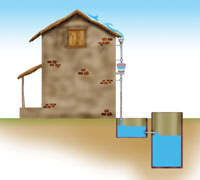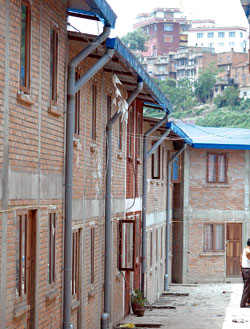|
|
| Newly built housing complex in Kirtipur for squatters has rainwater harvesting system that can collect 60,000 ltrs of rainwater. |
One of the biggest ironies of life here in the world's most water-rich nation is the scarcity of safe drinking water for the capital's thirsty population.
The Nepal Water Supply Corporation (NWSC) can meet less than half the capital's daily demand of 220 million litres (mlt). The corporation can only meet 165 mlt in the wet season and 100 mlt during the dry season. So most people still get their water from wells dug ages ago, stone water spouts, tube wells that pull water from underground reservoirs and tankers that fill up at streams on the outskirts of the capital and deliver close to home.
But traditional water sources are endangered as the Valley's demand for water grows by two percent each year. Of the roughly 34 ponds in Patan, only 11 remain. Visit the 381 water spouts, or hittis, in the valley and you'll see water squirting from maybe a handful of them. Tubewells have gone dry. The only project to augment the Valley's water supply, Melamchi, is delayed and at least 10 years away. What do we do till then?
The only answer: start collecting rainwater. "Purified properly, rainwater is perfectly safe for all kinds of purposes, even drinking," says Prakash Amatya of Forum for Urban Water Sanitation, handing us a cup of tea made with rainwater harvested from the roof of his office.
Harvesting rainwater is simple. You collect it from the roof, filter it using a simple screen, collect the water in a tank, purify it and then use it for washing, cleaning, watering the garden and even drinking if you purify it properly.
Installing a simple harvesting system in a private house costs as little as Rs 3,000. The amount of water collected depends on the rainfall and the surface on which it lands. With Kathmandu's rainfall and a roof collection area of 100 sq m, a household can collect 128 cu m of water annually-more than enough for a five-person family. The only catch: you need a tank to store all that water.
Kathmandu gets an average of 1,600mm of rain a year. But 80 percent of this falls in the three monsoon months and much of it goes to waste. But with underground supplies being sucked dry by tubewells and shrinking of open spaces that help to recharge underground water, alternatives are needed.
In fact, rainwater harvesting can even help to recharge the ground water supply. Collected water can be drained into a soak pit made from layers of sand, gravel and charcoal (considered the best purifiers and filters). Water collected this way will automatically seep underground, recharging ground water.
The Ministry of Physical Planning and Works is now finalising its urban water supply policy which aims to ensure that new housing developments include rainwater harvesting. "It could be difficult to make it mandatory but we are trying to create awareness about the advantage of rainwater harvesting," says joint secretary Purna Das Shrestha.
In fact, rainwater collection is not something fashionable environmentalists do, it has become a necessity for survival in Kathmandu.
 Where it has worked
Where it has worked
Rainwater harvesting systems have already been installed in various school buildings, campuses, housing complexes and even government departments. And everywhere, it has been heaven-sent.
The NGO Forum for Urban Water Sanitation has even trained plumbers who will come and fix the pipes in your house for a minimum charge. All you have to do is call 2042122.
Shuvatara School installed a rainwater collection system in 2004 at a cost of Rs 50,000. The four tanks can collect 10,000 litres. "We've been using rainwater for everything," says Mohan Niraula, the ecology and environment teacher who built the system.
Residents of a housing complex recently built on the outskirts of Kirtipur for squatters removed from the banks of the Bishnumati have to journey to fetch water from a communal tap in Kirtipur, one mile away. But once three large tanks to store 60,000 litres of rainwater are complete, none of the 44 families will need to walk the mile.



